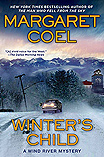 |
|
Arapaho Facts, Traditions & Beliefs "The drumbeat is like a heartbeat, connecting creatures and creator." The Arapaho Moons (from The Indian Way by Gary McLain) First Moon January The Moon When the Snow Blows like Spirits in the Wind Second Moon February Moon of Frost Sparkling in the Sun Third Moon March Moon of Buffalo Dropping Their Calves Fourth Moon April Moon of Ice Breaking in the River Fifth Moon May Moon When the Ponies Shed Their Shaggy Hair Sixth Moon June Moon When the Hot Weather Begins Seventh Moon July Moon When the Buffalo Bellow Eighth Moon Late July Moon When the Chokecherries Begin to Ripen Ninth Moon August Moon of Geese Shedding Their Feathers Tenth Moon September Moon of Drying Grass Eleventh Moon October Moon of Falling Leaves Twelfth Moon November Moon When the Rivers Start to Freeze Thirteenth Moon December Moon of Popping Trees Language Listen to Arapaho spoken by Arapaho elders on the Wind River Reservation, William C'Hair and Alonzo Moss, Sr. Click on Begin. Then click on word to hear it spoken. You can hear nouns, common expressions and other spoken Arapaho by clicking on words under Begin. 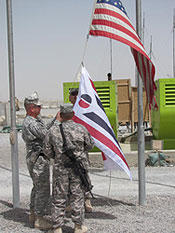 The website is the project of Andrew Cowell, Director of the Center for the Study of Indigenous Languages of the West at the University of Colorado.
The website is the project of Andrew Cowell, Director of the Center for the Study of Indigenous Languages of the West at the University of Colorado.
Warriors Arapahos are a proud warrior society, and many Arapaho men and women serve in the Armed Forces today. U.S. Army Staff Sgt. Alfred Duran from the Wind River Reservation raises the Northern Arapaho and U.S. flags at Forward Base Blackhawk in Spin Boldak, Afghanistan (image to right). 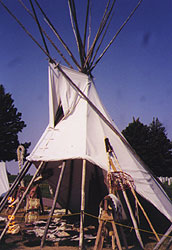 A Plains Indian tribe, the Arapahos once lived on the prairies of Colorado where the front range cities are today—Denver, Boulder, Fort Collins, Colorado Springs. Hunters and gatherers, they lived on the bountiful supply of buffalo from the huge herds that roamed the area. They also harvested wild vegetables and fruits which they pounded together with strips of buffalo meat to make pemmican, a beef jerky-type food that sustained them through the winter. They lived in buffalo hide tipis in villages set up in the shelter of cottonwood trees along the streams.
A Plains Indian tribe, the Arapahos once lived on the prairies of Colorado where the front range cities are today—Denver, Boulder, Fort Collins, Colorado Springs. Hunters and gatherers, they lived on the bountiful supply of buffalo from the huge herds that roamed the area. They also harvested wild vegetables and fruits which they pounded together with strips of buffalo meat to make pemmican, a beef jerky-type food that sustained them through the winter. They lived in buffalo hide tipis in villages set up in the shelter of cottonwood trees along the streams.
The striking good looks of the Arapahos caused comment by the first white people on the plains. They were tall and handsome and carried themselves with great dignity. The Arapahos maintained that their enemies, the shorter, stouter Utes, always wanted to steal Arapaho women to improve the looks of their own tribe. Meanwhile, the Arapahos stole horses from the Utes. Ledger books provide accurate historical records—in pictograph—of life on the plains and events in the lives of the Arapahos. These account books were traded by white people to the Arapahos and other Plains Indian tribes, along with pencils and crayons. The warriors drew pictures in the books detailing their experiences. The books first came into white society when soldiers took them off the bodies of warriors after a battle. Of the thousands of ledger books that some scholars believe once existed, all but about three dozen have been destroyed. Dealers cut and sold them by the page, and it is thought that the Arapaho tradition of burying important possessions with the dead accounted for the disappearance of many more. Most ledger books known to exist are in museums, although occasionally one will turn up on the market with an asking price that can top a million dollars. Wind River Reservation and the adjacent towns mentioned in the Wind River Mystery Series are real places in central Wyoming. The reservation covers nearly three million acres, extending 55 miles from north to south and 70 miles east to west. Of the 9,000 members of the Arapaho tribe today, about 7,000 live on the reservation. 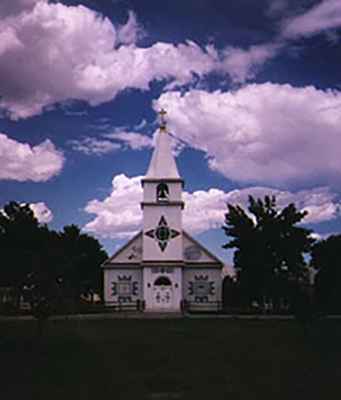 St. Francis Mission is the fictional name of the actual St. Stephen's Indian Mission on the reservation. The Society of Jesus (Jesuits) established the Roman Catholic mission in 1884 after the Arapaho chiefs asked the Jesuits to teach the children and donated the land for the numerous buildings in the mission compound. A high school and elementary school are still located on the premises, and Jesuit priests continue to work closely with the Arapaho people, providing religious and educational programs.
St. Francis Mission is the fictional name of the actual St. Stephen's Indian Mission on the reservation. The Society of Jesus (Jesuits) established the Roman Catholic mission in 1884 after the Arapaho chiefs asked the Jesuits to teach the children and donated the land for the numerous buildings in the mission compound. A high school and elementary school are still located on the premises, and Jesuit priests continue to work closely with the Arapaho people, providing religious and educational programs.
The Arapaho way is historically a way of life that is dignified, respectful, courageous, loyal and generous—a way Arapahos strive to live by even today. A deeply spiritual people, the Arapahos believe in a Creator, Be:he:teiht, and in the close relationship between the earth and all creatures. They have great respect for the elders who have climbed the four hills of life (child, adult, maturity and elder) and now dwell on the fourth hill—a holy place close to the Creator. Living in harmony in what they call the World House, they place great emphasis on sharing, believing that what a person gives away comes back a thousandfold. The richness of the Arapaho culture and beliefs can be seen today in the celebrations held throughout the year, especially in the Sun Dance. The Sun Dance, held for one week each July, includes many rituals and is the Arapahos, most sacred religious ceremony. Most prominent is the dance itself, which lasts for three days. Men and women will "pledge the dance," that is, take part in the dance. During the dance period they will have nothing to eat or drink. The dance is a prayer offered for The People (Arapahos) and for the specific intention of the dancers—for example, the health and well-being of their families. The Sun Dance is a time for the people to come together in peace and forgiveness. It is a quiet, beautiful time. 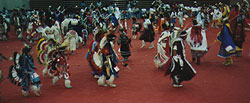 A powwow is a social dance—not religious in any way. Dancers perform various types of dances in competition with one another, and prize money is awarded to the winners. Highly skilled dancers often travel the competitive "powwow circuit" around the western United States.
A powwow is a social dance—not religious in any way. Dancers perform various types of dances in competition with one another, and prize money is awarded to the winners. Highly skilled dancers often travel the competitive "powwow circuit" around the western United States.
The eagle is a mediator between people and the creator because it flies the highest of all creatures and connects humans to the Creator. It is a messenger of the Creator, bringing blessings to His creatures. That is why the appearance of the eagle is always considered a good sign. Eagle feathers are considered sacred because they belong to a sacred bird. The Arapaho language is a beautiful, melodic language. A complex language, it is very difficult to learn—today, few young Arapahos are able to speak or write it. For example, "niatha," meaning "white man," is also the word for spider, a dangerous creature capable of strange and wondrous things. 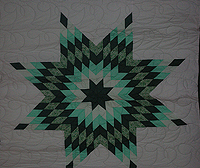
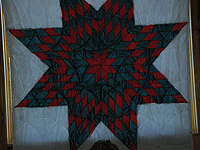
|
|
|
|
